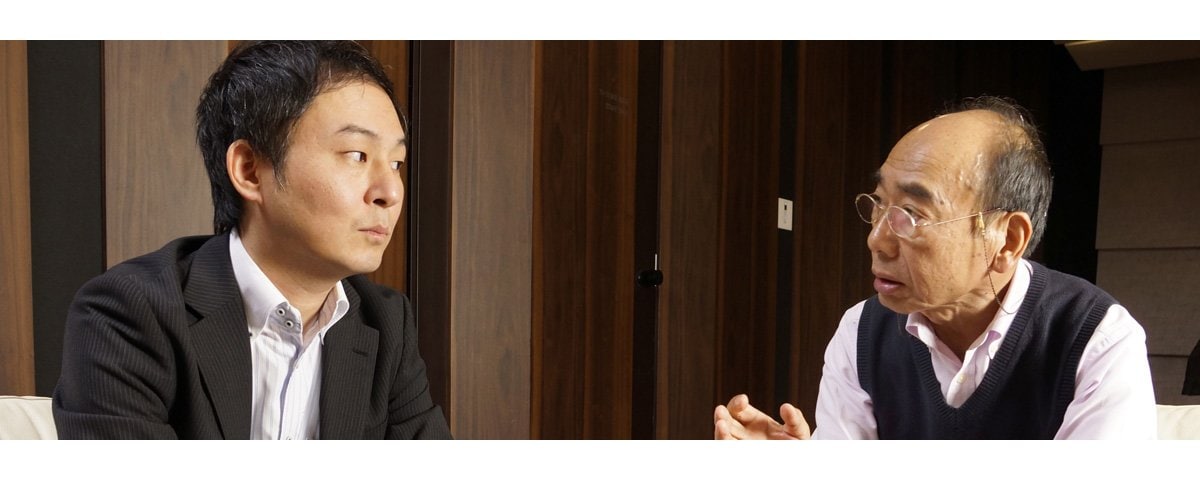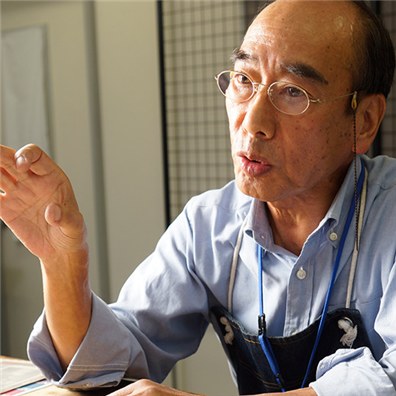Part 3: What is significant design concept which we have learned from artists?
Yamaha Flute "Artist meets Yamaha Artisan"
Yoshiyasu Hara × Keisuke Tanaka
Tanaka - Not only expanding the range of basic flute culture but also meeting the demands of top artists at the same time.
― In the last session, we heard that the history of the Yamaha handmade flutes began with relationships with several French-style flutists such as Mr. Rampal. Regarding product history, the handmade flute that Mr. Hara was involved came from the period when a model name still had only two-digit numbers.
HARA – Yes, the first handmade models were FL-61/63 (French-style/German-style), and they became FL-81/83 in 1975. After that in 1981, the model numbers of those handmade flutes changed to three-digits.
The “Type 4” was derived from the “Type 1”, and expanded through Germany.
TANAKA – the last digit number of model name represents the pitch and scale design. It began in the period of Mr. Hara with number “1” (Type 1) which derived number “4” (Type 4), and finally number “7” (Type 7) was born when another handmade model 900/800 Series was developed. Consequently there are three types of basic pitch and scale design.
HARA – I had been engaged until Type 4.
― Was the Type 1 led by the encounter with Mr. Rampal’s Louis Lot flute?
HARA – Yes, it was based on a French-style centered on Louis Lot. Although there were other manufacturers like Hammig which were based on a German-style, we were trying to focus on a French-style, and as a result, many French flutists chose our instruments. However, there were some flutists like Mr. Adorján who were studying in France but at the same time playing often in German orchestras, and they gave us opinions which were aiming at a different direction from flutists like Mr. Rampal. And also sales persons wanted models which could be offered not only in France but also in Germany. Therefore, we developed Type 4 which had a Type EC head joint. Regarding the development of Type 4, we adopted opinions from Mr. Paul Meisen in addition to Mr. Adorján.
TANAKA – By the way, the head joint of Type 1 flute was Type CY.
HARA – The early Type 4 models expanded through Germany centering on München, and flutists including those who won the Kobe International Competition and who are currently playing in orchestras in Germany also picked up those Type 4 flutes. However, Mr. Adorján still wasn’t satisfied with those instruments, and our new challenge began in the period of Mr. Tanaka trying to fully satisfy Mr. Adorján.
TANAKA – That’s right. The result of the challenge was 900/800 Series, a Type 7 model which was launched in 2011. Since Mr. Adorján was already satisfied with the pitch and scale design, we didn’t make a lot of changes in the tone hole positions from Type 4, but we did change its head joint. What Mr. Adorján wanted was a more dynamic and rich sound, so he needed an instrument to have bigger capacity which would allow him to blow harder without breaking sound and enable him to realize a wider range of expression. That’s what we achieved with 900/800 Series.
C-sharp of “The Afternoon of a Faun”
HARA – The tone hole positions of Type 4 are totally different from Type 1. The scale of Type 4 is close to equal temperament so it gave players more expressive freedom and tone color something which Mr. Adorján had sought.
― How would you describe the type 1 scale?
HARA – As I mentioned before, Type 1 is based on a French-style. French-style flutes like Louis Lot are suitable for expressing subtle nuance; for example, when playing the first C-sharp of Debussy’s “The Afternoon of a Faun”, a French-style flutist would take a little bit higher pitch to express a sense of anxiety. If he takes the C-sharp in equal temperament, it wouldn’t be interesting. A composer writes music being aware of these specific features of each instrument.
The same thing can be said on the pitch D. A French-style flutist tends to take a slightly higher pitch when playing the D of Mozart’s concerto. At competitions in Japan, we sometimes hear that the pitch of D in the second movement of Mozart’s concerto is a little bit lower, which somehow doesn’t sound aesthetic. In general, French-style flutes tend to sound slightly higher, while German-style flutes don’t have that kind of tendency except for Helmuth Hammig.
French-style flutes and German-style flutes have different thoughts about the tone holes. Basically, the scale and pitch of old French-style flutes seem to be slightly lower. On the other hand, the length of a Helmuth flute is a little bit short and almost has A442 Hz. In Germany, since most flutists’ are focused on their orchestral, a flute which has a lower pitch is not practical. Meanwhile, French-style flutists put more weights on solo performances and they pursue more flexibility in expression. Mr. Graf used to say, “With a German-style flute, it is hard to express in the same way as painting with a lot of colors.” On the other hand, a German-style flute is suitable for playing massive and dignified German-style music.
TANAKA – However, the pitch accuracy is getting more and more important nowadays. Since there are many opportunities to play different styles of music which often require extended techniques, a flutist needs to be able to play with accurate pitch more easily than before.
HARA – Exactly.
TANAKA – If there is a risk to lose his job if he plays off-pitch, he would choose a more secure instrument with which it is easier to play in tune. However, in that case, as Mr. Hara said…
HARA - It becomes boring. Those soloists used to make the sound more colorful unconsciously by playing slightly higher or lower pitch. However, there are not a lot of “soloists” these days. Even those who often play solo have a position in an orchestra. Both Mr. Rampal and Mr. Larrieu used to belong to orchestras when they were young, yet they were natural born soloists and what they were seeking was different from the others. They were always trying to find out how they could paint the music with more splendid colors.
The appearance of 900BJ/800BJ Series was astonishing.
― 900BJ/800BJ Series(Japan domestic model) (1997) which was developed with Mr. Shigenori Kudo is a traditional French-style flute just like the ones you mentioned, right?
HARA – Yes. It has more French-style features than Type 1.
TANAKA – The appearance of 900BJ/800BJ Series was astonishing. Even other manufacturers told us that they couldn’t believe that Yamaha had actually launched it.
HARA – Well, it couldn’t be launched if it wasn’t Yamaha.
TANAKA – I agree. Normally, a newly developed flute is supposed to be designed easier to play with more volume, but 900BJ/800BJ Series was the opposite. Even though experts know that a brilliant goal awaits after playing it for a while, it gives an impression that it is an extremely difficult instrument to master for those who expect an immediate result.
Therefore, we are very proud that only Yamaha can offer such an instrument in this day and age.
― 900MV/800MV Series was launched in 2007, derived from “900BJ/800BJ Series”.
TANAKA – 900MV/800MV Series took over the concept of 900BJ/800BJ Series, but we made it a little bit easier to play.
HARA – Mr. Kudo asked us if we could develop a flute like 900BJ/800BJ Series which music college students would also be able to play. 900BJ/800BJ Series has an 900/800 Series design like Louis Lot. However, college students wouldn’t play 900BJ/800BJ Series because they need to deliver an expected result within four years but it takes more time to master 900BJ/800BJ Series. Therefore, 900MV/800MV Series was developed so that they could also be satisfied.

No compromise even on standard models!
― Yamaha beginner flutes (standard series) are also Type 1. Does it mean that not only handmade models but also models for beginners have elements of a French-style flute?
TANAKA – Yes. Although the pitch and scale design of the current standard series is Type 2 after the model change in August last year, it has exactly the same tone holes position and Type CY head joint as Type 1. We still hear many people say that this educationally helpful design should remain same.
HARA – Mr. Nicolet once told us, “We need to blow from our stomach to make the low range sound right. Beginner models have to be the ones with which students can learn these basic techniques correctly.”
If a student starts learning with an “easy-to-play” flute, he wouldn’t be able to learn how to play the flute using the entire body, and consequently he wouldn’t be able to become a specialist. Mr. Nicolet also told us that it was our responsibility to keep making these educationally helpful and sincere instruments.
Of course we have made a little adjustment in the embouchure hole since it is for beginners, but you will find more adjustments in beginner models of other makers, such as highly raised wall and bigger cut in the embouchure. However, a student who starts with this “easy-to-play” flute will face many difficulties when wanting to improve. Yamaha holds a substantial share of the market for beginner models, especially in Europe; therefore, we need to be aware of our responsibility.
― Do many flutists understand the concept?
TANAKA – Many educators understand our thoughts very well. Since they grew up with “right instruments” and became flutists, they understand the process of improvement and realize the significance of the head joint when they begin teaching. It is easy to make an “easy-to-play” instrument. However, it will just be a boring instrument which keeps ringing in same way. If we start making that kind of instrument, the uniqueness of flute culture would be lost.
HARA – It is more difficult to play pianissimo with a bigger embouchure cut. With that type of instrument, the musical density always remains same and the music tends to be less exciting, which is not appreciated well in competitions either.
All Yamaha flutes from beginner models to handmade models used to have Type CY head joint in common. After that, many other head joints were developed, but after all, they have been reduced to currently existing seven types.
TANAKA – Type A head joint was developed for 900/800 Series supported by Mr. Adorján, Type Y was named after Type CY (exactly same design), Type H is for 900BJ/800BJ Series, and Type M is for 900MV/800MV Series.
I developed Type K with Mr. Jeffrey Khaner (Principal Flutist of The Philadelphia Orchestra) when I was in the U.S. Type E is same as Type EC, and Type C is a modified version of Type CY.
Changed the image of Yamaha!
― Mr. Adorján says that there is no need to choose another head joint for 900/800 Series.
TANAKA – In the case of 900/800 Series, the head joint and the body were developed together as a complete unit; therefore, we would like players to try this combination first. Since the gold head joint of 900/800 Series is 0.43mm thick (very thick compared with others), we adjusted the thickness of specific parts of the body in order to balance with the design of the head joint.
― What kind of impact did 900/800 Series bring to flutists?
TANAKA – It surely changed their image and evaluation toward Yamaha flutes. It may sound wired but many flutists have told us, “this isn’t like Yamaha.” When I was in the U.S, many orchestra members used to tell me that a Yamaha flute was good for a second flute part, but recently I have heard a lot that the image has changed in a positive way.
― The professional model 700/600/500 Series is also Type 7. Does it mean that it also shares the design of 900/800 Series?
TANAKA – Yes, we applied what we had accomplished with 900/800 Series to the lower models. The head joint of “700/600/500 Series” is Type Am which has similar sound features to the Type A head joint of 900/800 Series. At the same time, it has common elements with the Type CY head joint of the standard model. The whole model line-up is designed so that a player who starts with a standard model will be able to reach a handmade model (900/800 Series) without any difficulties.
Beloved Yamaha wooden flute
― How was the Yamaha wooden flute developed?
HARA – Actually, we had been experimentally developing a wooden flute. One day, Mr. Kudo performed St Matthew Passion at Saito Kinen Festival with conductor, Mr. Seiji Ozawa. It was there he played the prototype wooden flute as a trial. As a result, Mr. Ozawa loved the sound and said, “Yes! That’s the exact sound I wanted!” and because of that, Mr. Kudo recommended us to develop it officially.
TANAKA – Yamaha has abundant knowledge about wooden materials and manufacturing technology acquired from clarinet and oboe manufacturing. In fact, we are capable of making a wooden flute this thin (3.2mm thickess).
― How does the thickness affect the sound?
TANAKA – A wooden flute with a thin body sounds clearer and its light sound can project further. The response would be duller if it had a thicker body. Furthermore, it has undercut tone holes, which cannot be made by other manufacturers. Yamaha wooden flutes are loved in Europe and the U.S.
HARA – The Royal Concertgebouw Orchestra also purchased our wooden flute.
TANAKA – It has great popularity. The only difficulty is to ensure the stable source of the wood material since we are selecting from limited stocks of fine wood.
Our significant responsibilities…
― Mr. Hara and Mr. Tanaka, both of you are engaged in flute design and have built good relationships with various artists from different periods. Do you feel any differences between each period?
HARA – The artists who I kept good relationships with are getting older, and some of them including Mr. Rampal and Mr. Nicolet have already passed away. Meanwhile, Mr. Tanaka is working with younger artists such as Mr. Mathieu Dufour, and it is natural that he is aiming at a different direction.

TANAKA – As we have mentioned, considering the substantial number of standard models we are providing, we feel the huge responsibility of supporting flute culture in general. Our current situation is built on the basis of the accumulated of our predecessors including Mr. Hara who have developed all the specifications and history which I would call “flute culture”.
The other thing I feel is that many flutists today are facing a difficult period, yet they are trying to explore the world and find new possibilities of expression. In fact, their performance styles and the range of expression are expanding continuously. The instruments also need to be improved along with their performance skills. I feel great responsibility in creating instruments that meet their demands.
Not only expanding the range of basic flute culture but also meeting the demands of top artists at the same time. These are our two significant responsibilities today and we always have to move forward constantly.
*This article is originally published in a Japanese monthly magazine "PIPERS" from October to December 2016 and includes contents at the time of the interview.
Yoshiyasu Hara
After graduating Tokyo Collage of Music, he joined Yamaha in 1971. Through his career in flute and piccolo development, he has gained trust from prominent flutists in Europe and America. He has been engaged in flute development as an advisor even after retiring from Yamaha in 2003. Organizer of "HARA flute workshop". Lecturer in Daikanyama Technical Academy.
Keisuke Tanaka
Manager for Flute, Piccolo, in Yamaha Corporation Woodwind Design Team. Mr. Tanaka has supported flutists from all over the world.







